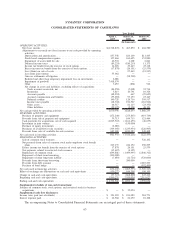Symantec 2009 Annual Report Download - page 126
Download and view the complete annual report
Please find page 126 of the 2009 Symantec annual report below. You can navigate through the pages in the report by either clicking on the pages listed below, or by using the keyword search tool below to find specific information within the annual report.offset to revenue. We fully reserve for obsolete products in the distribution channel as an offset to deferred revenue
for products with content updates and to revenue for all other products.
For our Security and Compliance and Storage and Server Management segments, we generally recognize
revenue from the licensing of software products through our indirect sales channel upon sell-through to an end-user.
For licensing of our software to OEMs, royalty revenue is recognized when the OEM reports the sale of the software
products to an end-user, generally on a quarterly basis. In addition to license royalties, some OEMs pay an annual
flat fee and/or support royalties for the right to sell maintenance and technical support to the end-user. We recognize
revenue from OEM support royalties and fees ratably over the term of the support agreement.
We offer channel and end-user rebates for our products. Our estimated reserves for channel volume incentive
rebates are based on distributors’ and resellers’ actual performance against the terms and conditions of volume
incentive rebate programs, which are typically entered into quarterly. Our reserves for end-user rebates are
estimated based on the terms and conditions of the promotional program, actual sales during the promotion, the
amount of actual redemptions received, historical redemption trends by product and by type of promotional
program, and the value of the rebate. We estimate and record reserves for channel and end-user rebates as an offset
to revenue. For consumer products that include content updates, rebates are recorded as a ratable offset to revenue
over the term of the subscription.
Financial Instruments
For certain of our financial instruments, including cash and cash equivalents, short-term investments, accounts
receivable, accounts payable and other current liabilities, the carrying amounts approximate their fair value due to
the relatively short maturity of these balances. The following methods were used to estimate the fair value of each
class of financial instruments for which it is practicable to estimate that value:
Cash and Cash Equivalents. We consider all highly liquid investments with an original maturity of three
months or less to be cash equivalents. Cash equivalents are recognized at fair value. As of April 3, 2009, our cash
equivalents consisted of $479 million in government securities, $474 million in corporate securities and
$389 million in money market funds. As of March 28, 2008, our cash equivalents consisted of $734 million in
commercial paper, $527 million in money market funds and $45 million in corporate securities.
Short-Term Investments. We classify short-term investments in accordance with SFAS No. 115, Accounting
for Certain Investments in Debt and Equity Securities. Short-term investments consist of marketable debt or
equity securities which are classified as available-for-sale and are recognized at fair value. The determination of fair
value is further detailed in Note 2. Our portfolios consist of asset-backed securities, corporate securities,
government notes, and marketable equity securities. We regularly review our investment portfolio according to
FSP FAS 115-1, The Meaning of Other Than Temporary Impairment and Its Application to Certain Investments.We
identify and evaluate investments that have indications of possible impairment. Factors considered in determining
whether a loss is other-than-temporary include: the length of time and extent to which the fair market value has been
lower than the cost basis, the financial condition and near-term prospects of the investee, credit quality, likelihood of
recovery, and our ability to hold the investment for a period of time sufficient to allow for any anticipated recovery
in fair market value.
Unrealized gains and losses, net of tax, are included in Accumulated other comprehensive income. The
amortization of premiums and discounts on the investments, realized gains and losses, and declines in value judged
to be other-than-temporary on available-for-sale securities are included in Other income, net. We use the specific-
identification method to determine cost in calculating realized gains and losses upon sale of short-term investments.
Derivative Instruments. We transact business in various foreign currencies and have foreign currency risks
associated with monetary assets and liabilities denominated in foreign currencies. We utilize foreign currency
forward contracts to reduce the risks associated with changes in foreign currency exchange rates. Our forward
contracts generally have terms of one to six months. We do not use forward contracts for trading purposes. The gains
66
SYMANTEC CORPORATION
Notes to Consolidated Financial Statements — (Continued)
























